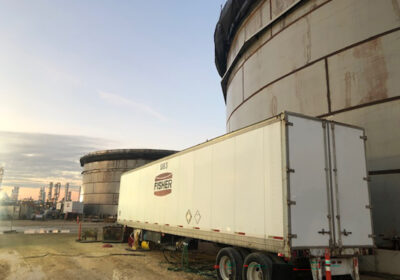TOOL SAFETY FOR STORAGE TANK CONSTRUCTION AND BACKYARD PROJECTS

isher Tank Company’s Jeanne Johnson shares some tool safety tips that apply not only to our crews building field erected welded steel tanks, but also to anyone working with tools and construction equipment. Tool safety seems like a common sense matter, but because tools can become so familiar, and their use so routine, they have the potential to be extremely dangerous. No matter how much on the job experience and safety training we have, we all benefit from basic reminders!
Hand & Power Tool Safety Tips
- Only authorized personnel should ever operate or attempt to repair power equipment.
- Damaged tools and unguarded machinery must be removed from use – and appropriately flagged as damaged/unguarded.
- Tools, equipment or material must be transferred by the use of a hand line or other safe, suitable method – never hrown up or down from one working level to another.
- Before starting power equipment, be sure that no one will be endangered by gears, belts or other moving part of the machinery and all guards are secured in place.
- Do not wear gloves, loose or torn clothing around moving parts of machinery.
- Shut down machinery and use extreme caution when cleaning or making adjustments.
- Be sure the machine cannot be operated before removing safety guards when cleaning, making repairs or adjustments.
- Prevent others from starting up equipment which you are working on by using a lock out/tag out system.
- All fuel powered motors must be shut down before fueling. Only approved safety cans or refueling equipment shall be used to refuel and must be bonded to unit being serviced.
- Gasoline as not a safe cleaning solvent – never use it as such!
- Compressed air is not to be used to clean skin or clothing.
- Use power equipment to its rated capacity only -never beyond. This also means ropes, cables, chains, hooks, etc.
- Remedy or report all unsafe conditions and equipment to your foreman
Electrical Tool Safety Tips From OSHA
- Never carry a tool by the cord.
- Never yank the cord to disconnect it from the receptacle.
- Keep cords away from heat, oil, and sharp edges (including the cutting surface of a power saw or drill).
- Disconnect tools when not in use, before servicing, and when changing accessories such as blades, bits, etc.
- Avoid accidental starting. Do not hold fingers on the switch button while carrying a plugged-in tool.
- Use gloves and appropriate safety footwear when using electric tools.
- Store electric tools in a dry place when not in use.
- Do not use electric tools in damp or wet locations unless they are approved for that purpose.
- Keep work areas well lighted when operating electric tools.
- Ensure that cords from electric tools do not present a tripping hazard.
- Remove all damaged portable electric tools from use and tag them: “Do Not Use.”
- Use Double-Insulated Tools.
Following these simple guidelines can save lives and can prevent countless injuries at the job site as well as at home. Whether you’re building a huge welded steel storage tank or a small backyard project, hand and power tools have the same potential for danger. Use them carfeully, wisely and safely!

OSHA offers much more information realted to hand and power tool safety, including Power Point presentations and YouTube videos.
Click here to read more of our blogs




